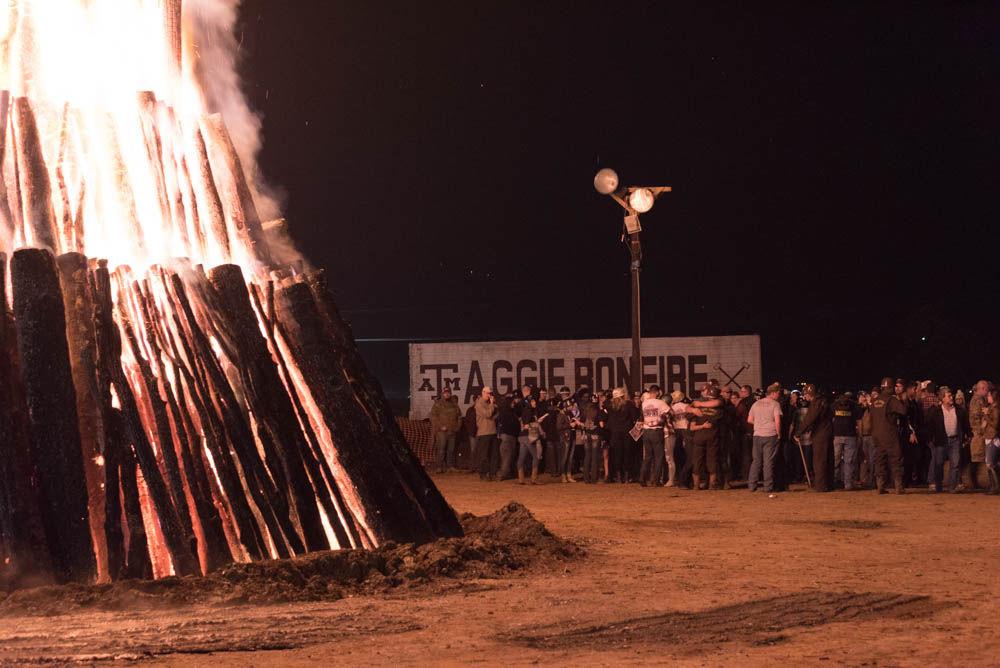Established four years after the bonfire collapse of 1999 and without the support of the university, Student Bonfire has since evolved into an organization with a different method and purpose, while keeping the same core commitment to the Aggie family.
The Aggie Bonfire, a 90-year old Aggie tradition, was originally burned to represent Aggies’ “burning desire to beat t.u.,” as many say. Following its collapse in 1999 which resulted in the deaths of 12 A&M students, the university rescinded its support and Bonfire ceased to occur.
The tradition was revived independently in 2003 as “Student Bonfire,” and with its revival came concrete changes both in its organization, policy and motivation for holding the tradition.
John Rudis has been involved in Student Bonfire since his freshman year and has worked his way up to become one of the three Senior Red Pots, the leaders at the top of the Student Bonfire hierarchy. Rudis is the Head Stack— the Red Pot who presides over the building of the bonfire itself.
Rudis said that prior to ’99 there were a total of nine Senior Red Pots, but there are only three now. The organizational change occurred because fewer people participate compared to the past and leadership in Student Bonfire is not as glamorous it was prior to ‘99, Rudis said.
“Whenever bonfire was back on campus, the senior reds were celebrities and the juniors were celebrities, basically,” said Rudis, who was a Junior Red last year, the rank directly below Senior Red.
Aside from the changes in leadership structure, the number of students involved decreased after ‘99. Previously, the larger number of students involved affected the level of organization the leaders were able to implement, Rudis said.
“Everybody in the dorms would come out. There wasn’t a whole lot of orchestration, not a whole lot of the organization we have to do nowadays,” Rudis said. “But there was still the hierarchy of crew chiefs, upperclassman and all that.”
Ann Goodman, the advisor of the Women’s Bonfire Committee prior to ‘99, said Bonfire used to be more like an “Aggie holiday” and that anybody and everybody could go to build — all they had to do was participate in a safety class.
With the large number of people involved there were also problems with alcohol consumption, Goodman said, who also worked with A&M alcohol and drug education prevention programs prior to ’99.
“Like any college tradition, alcohol and the prevalence of its use often found its way into the activities,” Goodman said. “So, from a professional perspective, I was also working to essentially discourage irresponsible alcohol consumption during the bonfire when it was lit.”
In strong contrast to the alcohol culture of the past, today there is a strict no alcohol policy for both those who build the fire and for those who attend the burn night itself, according to Senior Red Pot Joshua Murray.
“People can’t be showing up drunk and causing problems, because that’s dangerous,” Murray said. “We’ve changed and we’ve made a promise to keep it that way.”
But the biggest change in the tradition has to do with the meaning behind the bonfire itself. The original purpose of igniting the Aggie Spirit has been somewhat altered, Goodman said.
“The first Bonfire, it was a pure tradition. It was purely a reflection of our desire to beat the hell out of t.u., and it was about igniting this spirit among the campus, the community, it was a holiday,” Goodman said. “And that is not something that everybody embraces with regard to the new bonfire.”
What is fully embraced is the element of remembrance, said Rudis, who added that that they stop building the night of Nov. 17 in order attend the Bonfire Remembrance Ceremony.
“It’s still the same desire, that same Aggie Spirit, but now instead of dedicating it to beating t.u. and that being the whole mindset behind it, we build it in memory of them,” Rudis said.
Bonfire burns tonight, November 21, 2017. For more information on attendance, location and parking, visit the Student Bonfire website.
A new flame
November 21, 2017
Photo by Photo by Cassie Stricker
Members of Student Bonfire at the 2016 Burn Night.
0
Donate to The Battalion
$2790
$5000
Contributed
Our Goal
Your donation will support the student journalists of Texas A&M University - College Station. Your contribution will allow us to purchase equipment and cover our annual website hosting costs, in addition to paying freelance staffers for their work, travel costs for coverage and more!
More to Discover










